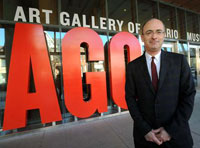 Knelman: Gallery's enchanted evening lost in haze of PR hangover
Knelman: Gallery's enchanted evening lost in haze of PR hangover
Revelation of big bonuses during time of restraint has injured CEO and squandered goodwill
Published On Mon Apr 12 2010 Matthew Teitelbaum's $665,000 bonus for seeing through the AGO renovation has damaged the institution's reputation for transparency and openness.
VINCE TALOTTA/TORONTO STAR FILE PHOTO
By Martin Knelman Entertainment Columnist
Nov. 12, 2008, was a triumphant night for the Art Gallery of Ontario's board and its CEO, Matthew Teitelbaum. It was a time for patting themselves on the back and revelling in success as the doors reopened after the place had been expanded and reinvented by architect Frank Gehry.
The gallery had climbed to another level in the eyes of the world, and board members were proud of raising millions and seeing the project through.
But two weeks ago, that same board inflicted severe damage on its own reputation when, at the last possible moment before it would be disclosed by the Ontario government, Tony Gagliano, its current president, broke the news to the staff that the board had paid close to $1 million in project bonuses to Teitelbaum and six other senior executives.
The timing could not have been worse, partly because the AGO had just announced a round of layoffs, and was involved in tense negotiations with a union that represents about 400 employees. It takes a great effort by many people to make a huge project work, but the message seemed to be that this board valued only a few top executives while failing to appreciate the rest of its team and betraying their trust.
Unfortunately, the world had changed since that big night in November 2008; after the global financial meltdown, wildly excessive bonuses for CEOs became a symbol of corporate creepiness.
Gagliano used the words "transparent" and "open" to describe the gallery's handling of the startling bonus information. But a clumsy announcement just hours before it was to become public via the Ontario government's annual salary disclosure list gave exactly the opposite impression – inviting buzz throughout the culture world about distasteful backroom deals.
Result: a public-relations fiasco.
According to Gagliano, Teitelbaum's $665,000 reward and the $250,000 shared by six other executives were approved by the board shortly after the opening and paid in early 2009. But they remained hidden from the staff, the media and all but a few AGO supporters even when, a year ago, in the face of layoffs and budget cuts, the gallery piously announced that senior management was taking a salary freeze to share the pain and set an example of fiscal responsibility. In retrospect, that echoes as hypocritical posturing.
Ethics aside, it was a strategic blunder to keep the bonuses secret until the last possible minute. The effect was to wipe out the admirable strides the AGO had made over the past six years, when it seemed to have become truly transparent and open in its dealings with the public, the media, its own staff and its neighbours.
There is no doubt Teitelbaum deserves a lot of credit for seeing the project through. Raising the money, finishing construction and opening the doors are certainly important steps in making a project successful. But the hardest part comes when you have to operate the new facility and implement a business plan. And in the early months of 2009, the AGO came close to disaster, from which it was saved by a government bailout.
The board wanted to ensure Teitelbaum did not take another job before the project was completed. But it's a dubious tactic to use the prospect of a bonus as a way of holding a leader hostage. Why would you want to keep someone who prefers to leave?
And when more than 40 per cent of an institution's operating costs are paid by Ontario taxpayers, you actually do have to be open and transparent, not just use those words to defend behaviour that is anything but.
It's just not acceptable for the AGO to have a board wheeling and dealing as if they were operating a private bank, or even the Museum of Modern Art in New York, which is funded almost entirely by private donors.
Gagliano claims no public money was involved in the bonuses, and that certain trustees specified a certain part of their gifts be allocated for this purpose. But he declined to reveal the names, amounts and dates of these transactions. That leaves a lot of doubt, because the capital campaign is essentially one big pot, which included $63 million of government money as well as donations from individual patrons.
Teitelbaum's completion bonus showed up on the government's published disclosure list, but not included on that list was an extra $89,000 payment (for fundraising) from the AGO Foundation – which handles private money only, with no public funds. Wouldn't it have been smoother to set up a clearly separate bonus fund through the foundation?
The poisonous fallout may extend well beyond the AGO. Other cultural organizations may find it harder to raise money for their projects. But the biggest price for this snafu will likely be paid by the gallery. Disillusioned donors are calling the development office to complain. Some who have written cheques in the past vow never to do so again.
The irony is that in trying to reward their CEO, the board has injured him, shattering the confidence of those whose help he needs, and cancelling the goodwill showered upon him one enchanted evening in November 2008.
Martin Knelman's column on the arts appears every other Monday on this page.
 Knelman: Gallery's enchanted evening lost in haze of PR hangover
Knelman: Gallery's enchanted evening lost in haze of PR hangover